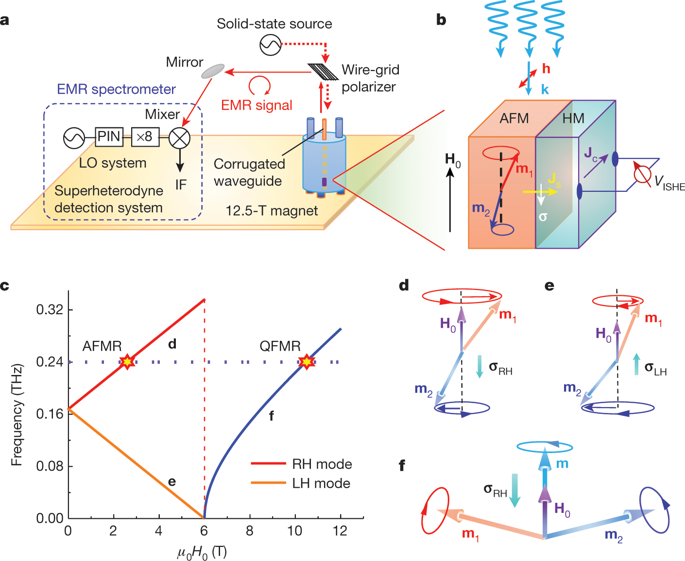Nature ( IF 64.8 ) Pub Date : 2020-01-27 , DOI: 10.1038/s41586-020-1950-4 Junxue Li 1 , C Blake Wilson 2, 3 , Ran Cheng 1, 4 , Mark Lohmann 1 , Marzieh Kavand 2, 3 , Wei Yuan 1 , Mohammed Aldosary 1 , Nikolay Agladze 2, 3 , Peng Wei 1 , Mark S Sherwin 2, 3 , Jing Shi 1

|
Spin dynamics in antiferromagnets has much shorter timescales than in ferromagnets, offering attractive properties for potential applications in ultrafast devices1,2,3. However, spin-current generation via antiferromagnetic resonance and simultaneous electrical detection by the inverse spin Hall effect in heavy metals have not yet been explicitly demonstrated4,5,6. Here we report sub-terahertz spin pumping in heterostructures of a uniaxial antiferromagnetic Cr2O3 crystal and a heavy metal (Pt or Ta in its β phase). At 0.240 terahertz, the antiferromagnetic resonance in Cr2O3 occurs at about 2.7 tesla, which excites only right-handed magnons. In the spin-canting state, another resonance occurs at 10.5 tesla from the precession of induced magnetic moments. Both resonances generate pure spin currents in the heterostructures, which are detected by the heavy metal as peaks or dips in the open-circuit voltage. The pure-spin-current nature of the electrically detected signals is unambiguously confirmed by the reversal of the voltage polarity observed under two conditions: when switching the detector metal from Pt to Ta, reversing the sign of the spin Hall angle7,8,9, and when flipping the magnetic-field direction, reversing the magnon chirality4,5. The temperature dependence of the electrical signals at both resonances suggests that the spin current contains both coherent and incoherent magnon contributions, which is further confirmed by measurements of the spin Seebeck effect and is well described by a phenomenological theory. These findings reveal the unique characteristics of magnon excitations in antiferromagnets and their distinctive roles in spin–charge conversion in the high-frequency regime.
中文翻译:

来自亚太赫兹产生的反铁磁磁振子的自旋电流
反铁磁体中的自旋动力学具有比铁磁体更短的时间尺度,为超快器件1,2,3的潜在应用提供有吸引力的特性。然而,通过反铁磁共振产生自旋电流和通过重金属中的反自旋霍尔效应同时电检测尚未明确证明4,5,6。在这里,我们报告了单轴反铁磁Cr 2 O 3晶体和重金属(β相中的Pt或Ta)的异质结构中的亚太赫兹自旋泵浦。在 0.240 太赫兹,Cr 2 O 3中的反铁磁共振发生在大约 2.7 特斯拉,它只激发右手磁振子。在自旋倾斜状态下,由于感应磁矩的进动,在 10.5 特斯拉发生了另一个共振。两种共振都会在异质结构中产生纯自旋电流,重金属将其检测为开路电压的峰值或谷值。电检测信号的纯自旋电流性质通过在两种情况下观察到的电压极性反转明确证实:当将检测器金属从 Pt 切换到 Ta 时,反转自旋霍尔角7,8,9的符号,并且在翻转磁场方向时,反转磁振子手性4,5. 两个共振处的电信号的温度依赖性表明自旋电流包含相干和非相干磁振子贡献,这通过自旋塞贝克效应的测量得到进一步证实,并且由现象学理论很好地描述。这些发现揭示了反铁磁体中磁振子激发的独特特征及其在高频状态下自旋电荷转换中的独特作用。



























 京公网安备 11010802027423号
京公网安备 11010802027423号